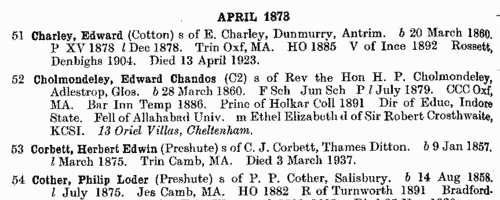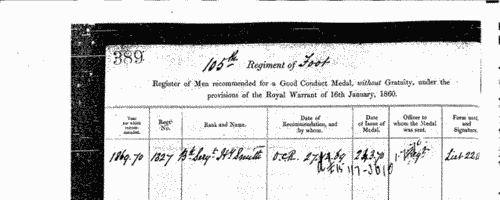Add this eBook to your basket to receive access to all 1,124 records. Our indexes include entries for the spelling sewell. In the period you have requested, we have the following 1,124 records (displaying 801 to 810): These sample scans are from the original record. You will get scans of the full pages or articles where the surname you searched for has been found. Your web browser may prevent the sample windows from opening; in this case please change your browser settings to allow pop-up windows from this site. Printer's widow elected to a pension
(1868)
The Printers' Pension Society was formed 3 December 1827 for 'the relief of aged, infirm, and distressed workmen, and their widows, in the several branches of the printing trade'. This list of pensioners elected through to December 1881 sets out in tabular form sequential number; year of election; full name (surname first); occupation (such as compositor, pressman, warehouseman, &c.); age at election; total amount paid (to December 1881 where still then living); and year of decease. The names of pensioners still alive at the end of 1881 are given in italics. The final column gives the number of husband or of widow in those cases where the spouse appears elsewhere in the list. | Sample scan, click to enlarge

| Stockton-on-Tees Voters: Stockton Polling District
(1868)
This poll book for the First Parliamentary Election for the Borough of Stockton-on-Tees lists the voters alphabetically by polling district, with full name (surname first) and address. In the right-hand column D represents the Liberal candidate, Joseph Dodds, Esq., and V the Conservative, Lord Ernest Vane Tempest. The three polling districts were Norton, Stockton (including so much of Linthorpe as lay within the parliamentary borough of Stockton), and Thurnaby. At the end of each district the handful of lodger voters are listed separately. | Sample scan, click to enlarge

| Boys entering Marlborough College
(1869)
The public school at Marlborough in Wiltshire was founded in 1843. In 1952 this, 9th, edition of the college register was published, being a revision by L. Warwick James of the 8th edition (of 1936): but for the years before 1936 it does not merely repeat the 8th edition, because Warwick James was able to correct the 19th-century entries with information from newly-discovered letters and books from 1843 to 1853, and the school lists from 1844 onwards. The roll is arranged by year, and within each year by term of entrance, and then alphabetically by surname within each term. Each boy is assigned a number within the year: then his name is given, surname first, and, in brackets, where a boarder, his house. The houses within the college were called B1, B2, B3, C1, C2 and C3, and the Lower School (L Sch); the out college houses were Preshute, Priory, Cotton, Hermitage, Littlefield, Barton Hill, Summerfield and Upcot. Then there is given the boy's father's name (surname and initials) and address (at entrance), the boy's date of birth (b) and month of leaving (l). Where the boy represented the school at Rugby football (XV) or cricket (XI), in the rifle corps (VIII, or RC XI), that is indicated. There is a brief summary of achievements in later life, and, where known, and date of death or (in italics) address as in 1952. | Sample scan, click to enlarge

| Science Schools and Classes: Elementary Examination: Class Lists
(1869)
The Science and Art Department of the Committee of Council on Education published these class lists giving the names of all the successful candidates in the examination of science schools and classes taken in May 1869. The candidates were of three levels: honours; second stage or advanced examination; third stage or elementary examination. Twenty-three subjects were offered. These are the lists for the elementary examination. The tables, arranged subject by subject, give the candidate's full name (surname first), age, and occupation - or, in the case of those not yet of working age, father's occupation, preceded by (f.). Many candidates sat and were successful in more than one subject, and so appear in more than one list. The subjects are: I. Practical, Plane and Solid Geometry; II. Machine Construction; III. Building Construction; IV. Elementary Mathematics; V. Higher Mathematics; VI. Theoretical Mechanics; VII. Applied Mechanics; VIII. Acoustics, Light, and Heat: IX. Magnetism and Electricity; X. Inorganic Chemistry; XI. Organic Chemistry; XII. Geology; XIII. Mineralogy; XIV. Animal Physiology; XV. Zoology; XVI. Vegetable Anatomy and Physiology; XVII. Systematic and Economic Botany; XVIII. Mining; XIX. Metallurgy; XX. Navigation; XXI. Nautical Astronomy; XXII. Steam; XXIII. Physical Geography. | Sample scan, click to enlarge

|  Men of the 57th Regiment who fought in the New Zealand War
(1860-1870) Men of the 57th Regiment who fought in the New Zealand War
(1860-1870)
New Zealand War Medal roll for the 57th (The West Middlesex) Regiment of Foot: for service in the New Zealand campaign 1863 to 1867: the rolls were compiled following a general order in 1869 and the medals were distributed in 1870. The regiment had been serving at Poonah in India, and was moved to New Zealand in November 1860; the men returned to England in April 1867. | Sample scan, click to enlarge

|  Outstanding soldiers of the 44th regiment of Foot
(1860-1870) Outstanding soldiers of the 44th regiment of Foot
(1860-1870)
The 44th (The East Essex) Regiment of Foot embarked for India in 1857, after returning from the Crimea. It was serving in India in 1860. It helped suppress the Indian Mutiny. The regimental depot was at Colchester. Each year just a handful of outstanding soldiers of the regiment were chosen for good conduct medals and gratuities: these are listed here. There were two lists, one for men recommended for the Good Conduct Medal without a gratuity, and one for gratuities - £5 to a private, £10 to a corporal, and £15 to a serjeant. Both lists are indexed here, and each gives rank, name, regimental number, date of recommendation and date of issue. (The sample scan is from the 105th foot) | Sample scan, click to enlarge

|  Artillerymen who fought in the New Zealand War
(1861-1870) Artillerymen who fought in the New Zealand War
(1861-1870)
New Zealand War Medal roll for the Royal Artillery: for service in the New Zealand campaign 1861 to 1866: the rolls were compiled following a general order in 1869 and the medals were distributed in 1870. | Sample scan, click to enlarge

|  Men of the 14th Regiment who fought in the New Zealand War
(1863-1870) Men of the 14th Regiment who fought in the New Zealand War
(1863-1870)
New Zealand War Medal roll for the 2nd battalion of the 14th (Buckinghamshire) Regiment of Foot: for service in the New Zealand campaign 1863 to 1867: the rolls were compiled following a general order in 1869 and the medals were distributed in 1870. The 2nd battalion, despite being part of the Buckinghamshire Regiment, was raised at Mullingar in Westmeath in 1857, and was sent to New Zealand in 1860, where it took part in the war of 1863 to 1865. In 1866 the men were sent to Australia, returning to England in 1870. | Sample scan, click to enlarge

|  Men of the Military Train who served in the New Zealand War
(1863-1870) Men of the Military Train who served in the New Zealand War
(1863-1870)
New Zealand War Medal roll for the Military Train: for service in the New Zealand campaign 1863 to 1867: the rolls were compiled following a general order in 1869 and the medals were distributed in 1870. | Sample scan, click to enlarge

|  Men of the Royal Irish regiment who fought in the New Zealand War
(1863-1870) Men of the Royal Irish regiment who fought in the New Zealand War
(1863-1870)
New Zealand War Medal roll for the 2nd battalion, the 18th (Royal Irish) Regiment of Foot: for service in the New Zealand campaign 1863 to 1867: the rolls were compiled following a general order in 1869 and the medals were distributed in 1870. | Sample scan, click to enlarge

|
Research your ancestry, family history, genealogy and one-name study by direct access to original records and archives indexed by surname.
|












